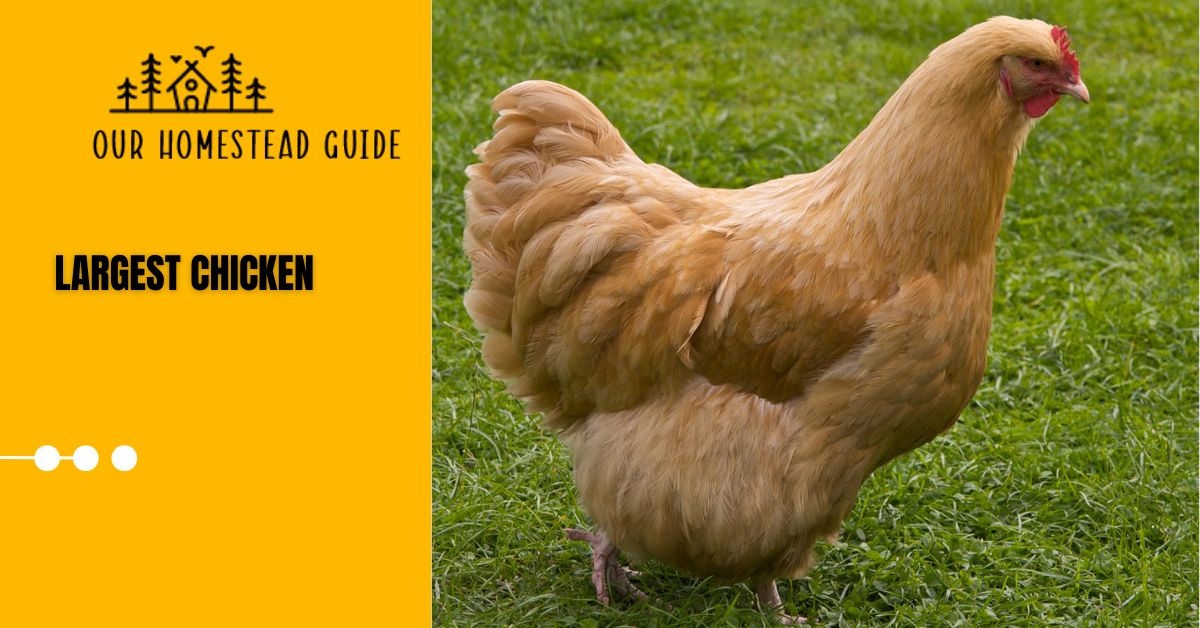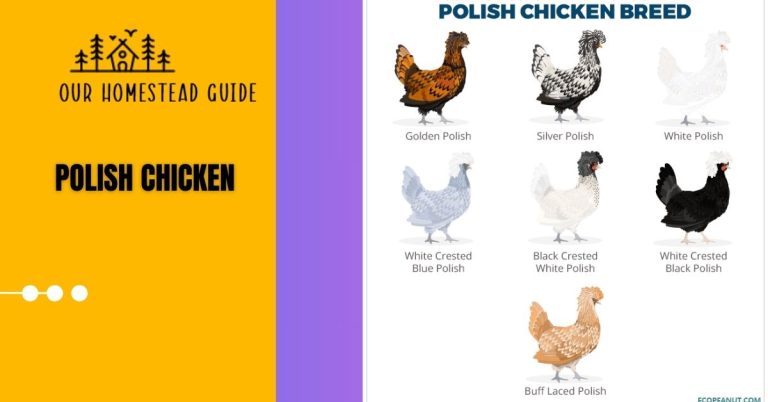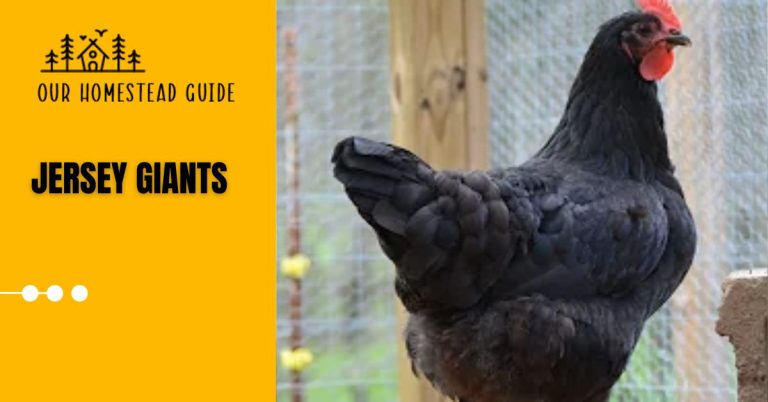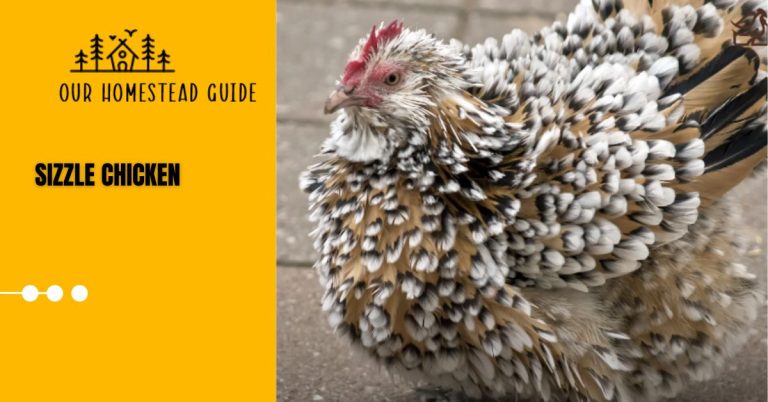12 Top Most Largest Chicken Breeds
Largest Chicken, Size matters when it comes to chickens. Hen body weight is the key to larger eggs, as the Manitoba government notes. Compared to smaller hens, bigger hens lay larger eggs.”
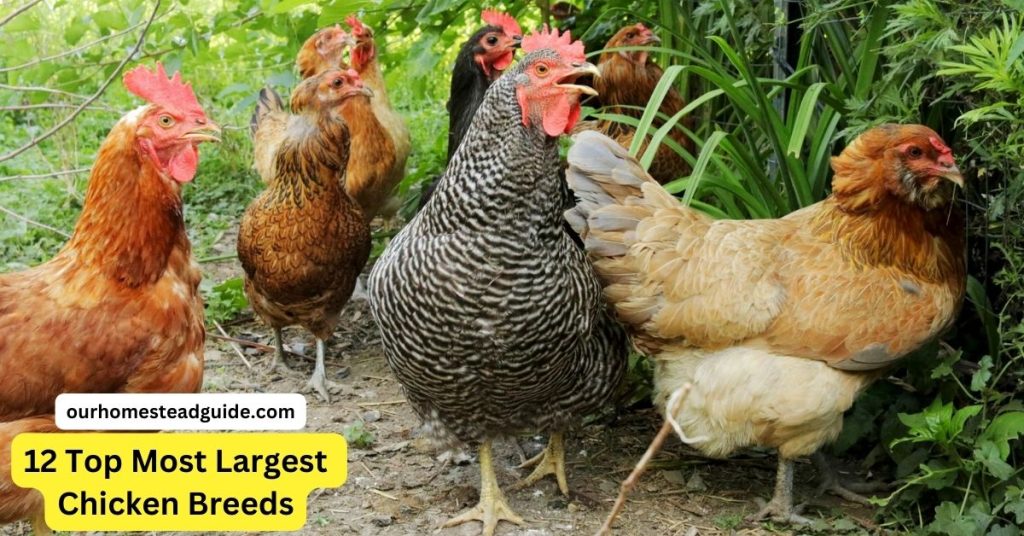
The Orpingtons and Brahmas are two of the most well-liked huge breeds. Given how lovely these gentle giants are, it is easy to understand why so many people decide to include them in their flock. There are, nonetheless, several other huge chicken breeds available.
Top 12 Largest Chicken Breeds
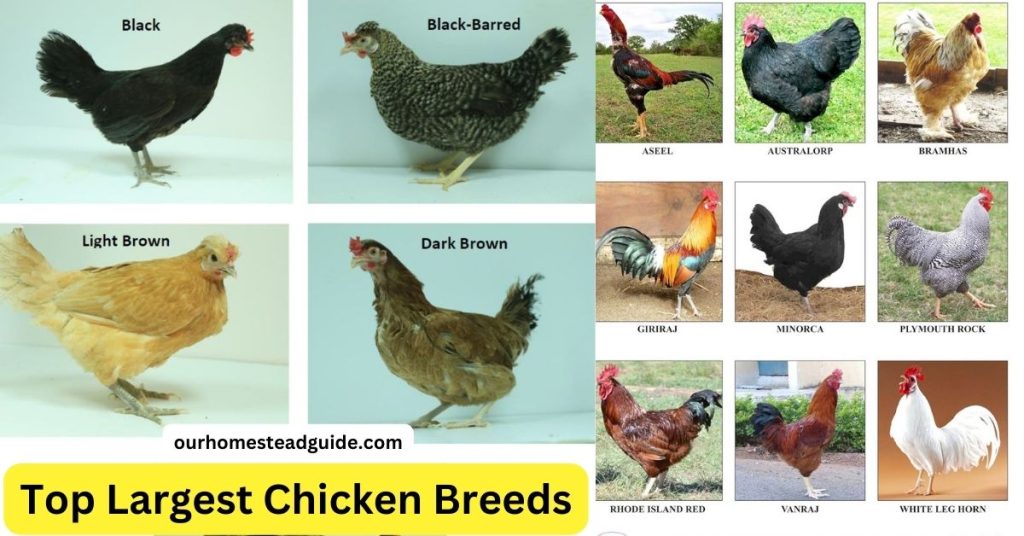
Looking for the largest chicken breed on the market? Here are 12 breeds that you should consider:
| Breed | Average Weight (Rooster) | Average Weight (Hen) | Height | Egg Production (per week) | Egg Production (per year) | Temperament | Notes |
|---|---|---|---|---|---|---|---|
| Jersey Giant | 13-15 lbs | 10-12 lbs | 25-26 in | 3-4 | 150-200 | Gentle, docile | Excellent dual-purpose breed |
| Brahma | 12 lbs | 9-11 lbs | 24-26 in | 3 | 150 | Calm, friendly | Good cold weather tolerance |
| Malay | 11 lbs | 8-9 lbs | 30-36 in | 2-3 | 120-150 | Alert, assertive | Upright posture, long legs |
| Dong Tao | 12 lbs | 9-10 lbs | 26-28 in | 2-3 | 150-160 | Active, playful | Unique green bones, prized in Vietnam |
| Cochin | 10-11 lbs | 8-9 lbs | 24-26 in | 2-3 | 120-150 | Docile, quiet | Fluffy feathers, ornamental breed |
| Orpington | 10 lbs | 8 lbs | 24-26 in | 2-3 | 120-150 | Friendly, curious | Good foragers, cold hardy |
| Langshan | 10 lbs | 8 lbs | 24-26 in | 2-3 | 120-150 | Calm, gentle | Large black eggs, good layers |
| Australorp | 9-10 lbs | 7-8 lbs | 24-27 in | 3-4 | 250-300 | Hardy, efficient | Excellent egg production |
| Cornish Cross | 9-11 lbs | 7-8 lbs | 22-24 in | 1 | 50-70 | Fast-growing, meat birds | Not good egg layers |
| Rhode Island Red | 8-9 lbs | 6-7 lbs | 22-24 in | 3-4 | 200-250 | Lively, active | Dual-purpose breed, good layers |
| Sussex | 8-9 lbs | 6-7 lbs | 22-24 in | 2-3 | 150-200 | Calm, friendly | Good egg layers, cold hardy |
| Plymouth Rock | 8-9 lbs | 6-7 lbs | 22-24 in | 2-3 | 150-200 | Docile, adaptable | Good all-purpose breed |
Jersey Giant
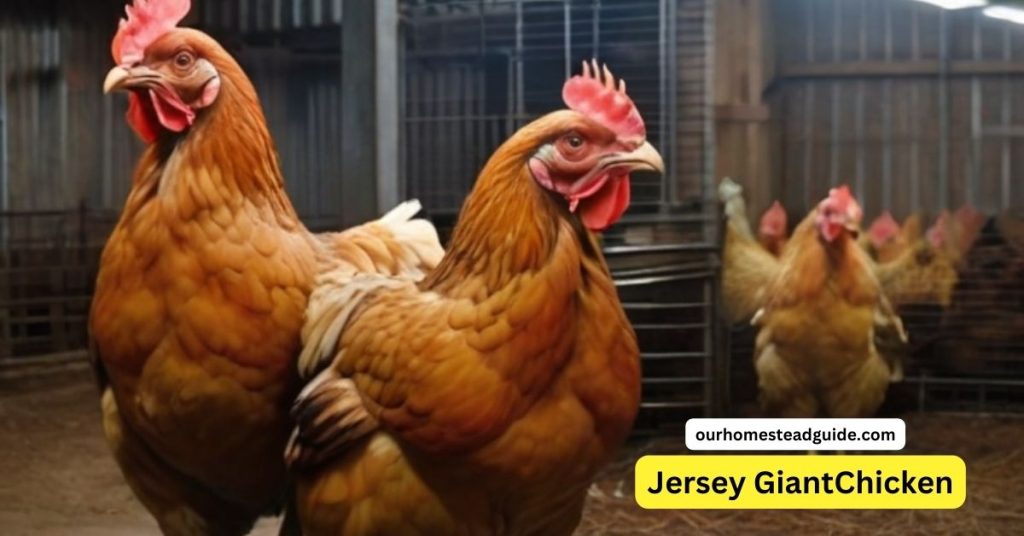
- Purpose: Dual-purpose (eggs and meat)
- Temperament: Relaxed and friendly
- Maximum Size: 15 lbs
In the case of the statuesque Jersey Giant, the moniker does say it all.
These roosters may weigh up to 15 pounds, making them possibly among the biggest chickens you will ever encounter.
Black Jersey Giants are typically a little heavier than white ones, for whatever reason.
They stand up to 26 inches tall – yes, over two feet! – and were initially produced as a heritage breed in New Jersey.
Originally bred as a rival to the domestic turkey, these kind and submissive hens are calm and quiet.
Nowadays, a lot of people grow Jersey Giants on their little farms because of their amiable nature, which makes them great companions.
Not only are they remarkable producers, but they lay between 150 and 200 big brown eggs a year.
Brahma
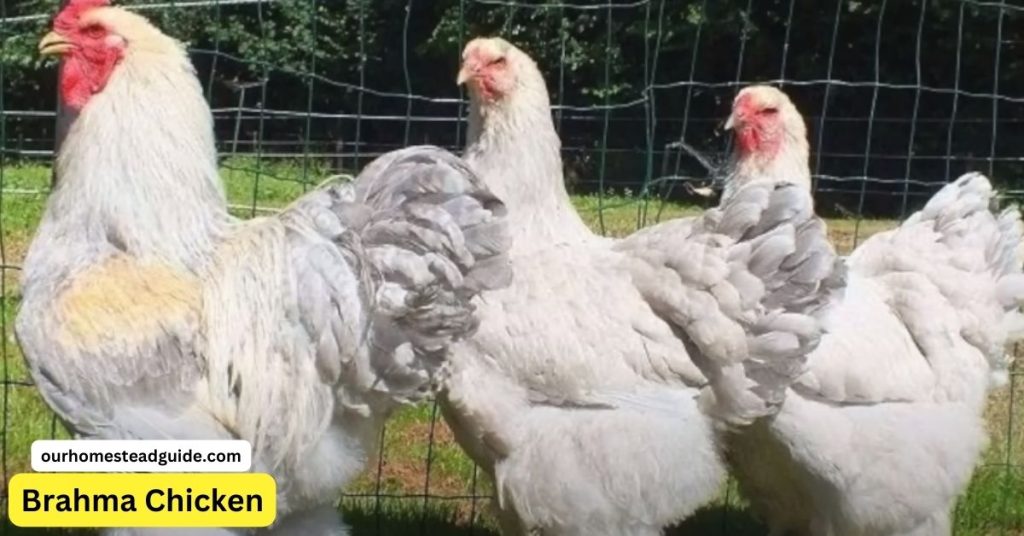
- Purpose: Dual-purpose (meat and eggs)
- Temperament: Docile
- Maximum Size: 10 lbs
It may surprise you to learn that the world’s largest bird is the Brahma fowl.
Although it may not be the largest breed, it has the best potential to develop to a very huge size.
There are several hues of Brahma chickens, including Light, Buff, and Dark. Brahma chicken is available in bantam sizes as well.
The Brahma chicken, sometimes referred to as the King of Chicken, has an amiable nature and makes a wonderful companion.
This rare type of old may grow to a height of up to thirty inches.
Brahmas lay up to 300 eggs a year and have feathered feet. They are also outstanding egg layers.
Malay
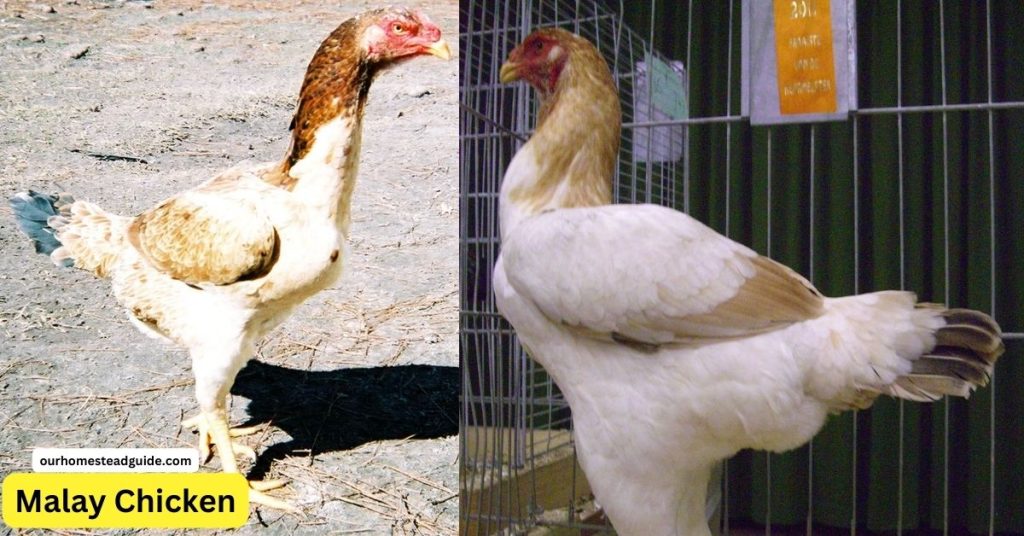
- Purpose: Ornamental
- Temperament: Aggressive
- Maximum Size: 9 lbs
Many people believe that the Malay chicken breed is the tallest breed of chickens.
The Malay can reach a height of 30 inches, although it’s not quite as large as the Jersey Giant or the Maline breed. Europe is where it started. as a hybrid of chickens indigenous to the Malay Peninsula and India. Due to their height, these birds became more and more popular there.
These hens, which measure around 9 pounds, provide a respectable amount of meat and eggs.
Nevertheless, these hens are somewhat uncommon and are primarily maintained for display and ornamentation these days. It is important to remember that Malay chickens may be quite hostile.
They may reach about 30 inches in height, making them several inches higher than the other hens in your flock. They have broad heads and robust bones.
These hens require a large amount of room due to their tendency toward aggression. They will be more aggressive the more self-assured they are.
These hens only lay less than 100 eggs a year, thus they don’t lay a lot.
This is because the chickens are seasonal layers, meaning that they will stop laying eggs in the middle of the season.
Dong Tao

- Purpose: Meat production
- Temperament: Good-natured and trusting
- Maximum Size: 12 lbs
Dong Taos are Vietnamese-originated and incredibly uncommon.
Their look is among the most peculiar of any chicken in the world, and they are classified as an endangered breed.
These birds have enormous, bloated feet and legs, and they weigh around 12 pounds. Their legs are really around the same thickness as the wrist of an adult male human!
Usually kept for their oversized and ungainly build, these chickens aren’t retained for egg production since they tread on their eggs before they can hatch.
In Vietnam, nevertheless, its flesh is prized as a delicacy.
Cochin
- Purpose: Dual-purpose (meat and eggs)
- Temperament: Affectionate and easy to tame
- Maximum Size: 5 lbs
The Cochin chicken is next on our list of enormous breeds of chicken.
Not only do these amiable, fluffy giants yield an incredible amount of meat, but they also have a beautiful appearance.
These hens have a thick covering of fluffy, downy feathers that make them extremely lovable.
They love to be handled — this is especially true if you pick the bantam kind of cochin, which is significantly smaller at only two pounds.
Cochins are docile and enjoy being given gifts. Cochins that are full-sized average 5 pounds in weight and produce eggs. About 160 eggs should be expected annually.
About 160 eggs should be expected annually.
Orpington
- Purpose: Dual-purpose (eggs and meat)
- Temperament: Calm
- Maximum Size: 10 lbs
Next up on our list of large chicken breeds is the Orpington chicken breed.
This historical breed, which originated in the UK’s Orpington district, comes in a few color variations, including:
- Black
- Buff
- White
- Chocolate Cuckoo
- Lavender Columbian
- Blue
- Columbian
- Lavender
- Splash
- Chocolate
There’s no size difference among the several variations, even if not all of these meet breed criteria.
These multipurpose hens are really relaxed and peaceful. Even though they are little, they adapt well to confinement.
Hens are an excellent option for anybody interested in hatching their chicks since they frequently become broody.
Great egg layers are also Orpingtons. These big hens, weighing around 10 pounds apiece, will also yield roughly 280 eggs annually.
Langshan
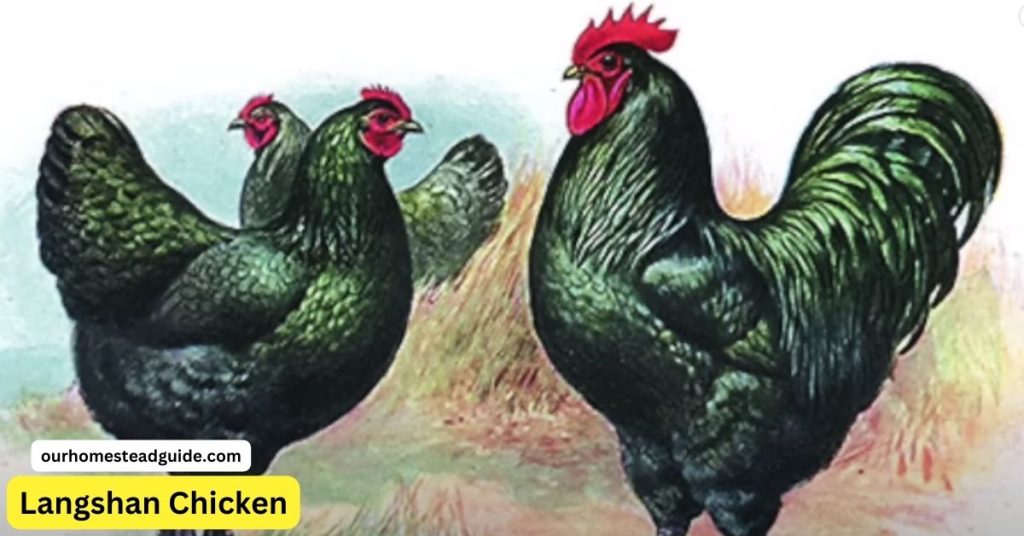
- Purpose: Dual purpose (eggs and meat)
- Temperament: Resilient
- Maximum Size: 9.5 lbs
Originating in China, Langshan chickens arrived in the United States during the 1800s.
These hens have feathered feet, which gives them a distinctive look that the show circuits value highly.
Langshan birds may weigh up to 9.5 pounds and lay 180 dark brown eggs a year on average.
In addition, they are very tall, towering above the other hens in a typical flock.
Although these hens get along well with people, their extreme heat tolerance makes them popular pets.
They thrive when left to their own devices and can withstand most types of weather.
This type of chicken is an expert forager, having little trouble obtaining food on its own.
Australorp
- Purpose: Dual-purpose (eggs and meat)
- Temperament: Hardy and docile
- Maximum Size: 10 lbs
A traditional chicken breed that is gradually regaining favor in the US is the Australorp.
Originating in Australia, the “or” in the name refers to the chicken’s kinship with the Orpington.
When it comes to size, roosters may reach up to 10 pounds, but hens can also put forth up to 300 eggs annually.
Rhode Island Red
- Purpose: Dual-purpose (eggs and meat)
- Temperament: Hardy
- Maximum Size: 9 lbs
Another well-liked breed of chicken that is frequently raised for their size is the Rhode Island Red.
These hens have glossy, silky red feathers that make them beautiful to look upon even though they are not intended to be decorative breeds.
Nowadays, Rhode Island Red breeds are mostly divided into two groups: heritage birds, which are often significantly bigger, and industrial birds, which are developed for maximum egg production.
Although they don’t usually provide as many eggs as commercial strains, these heritage breeds, which date back to the earliest European settlers, are very huge. A cocks weighs up to nine pounds.
Belgian
- Purpose: Ornamental
- Temperament: Nervous
- Maximum Size: 3 lbs
Although it’s not the heaviest breed, the Belgian chicken is one of the tallest.
This tall, slender, and muscular type of chicken is often referred to as the Liege Fighter.
It is a unique species with a very strong physique that was intended for combat. It features minimal combs and wattles, a high brow, and alert black eyes.
There are ten distinct colors and patterns available for this chicken, which is frequently found in varying tones of black.
In addition, the chicken’s legs, hocks, and four-toed feet are all black.
This chicken may grow to be as long as 30 inches and weighs only a few pounds at its biggest. It is virtually totally made of muscle.
New Hampshire Red
- Purpose: Dual-purpose (eggs and meat)
- Temperament: Hardy and aggressive
- Maximum Size: 9 lbs
Having only begun to be produced in the middle of the 1900s, the New Hampshire Red chicken breed is somewhat new.
This chicken was made to reach adulthood and maturity as soon as feasible.
It is currently one of the biggest and most well-liked breeds of chicken.
While roosters can reach up to nine pounds, hens typically weigh about six and a half pounds.
Since it is typically at the top of the pecking order, this aggressive bird needs a large coop and run.
This bird lays around 200 big brown eggs each year.
For those who desire both eggs and meat from their backyard flocks, this dual-purpose chicken offers the best of both worlds and is an excellent middle-ground option.
Delaware
- Purpose: Dual-purpose (eggs and meat)
- Temperament: Easygoing
- Maximum Size: 8 lbs
If you’re looking for a chicken breed that can produce both meat and eggs, the Delaware is a great option.
They only weigh six to eight pounds, so they aren’t the heaviest hens you will find, but they are excellent layers, laying approximately 280 eggs annually.
In the 1940s, a crossbreed between Barred Plymouth Rocks and New Hampshires produced Delaware chickens.
Because of its white coloring, this breed of broiler chicken is highly popular. It develops rather rapidly and is generally sociable.
Barred Rock
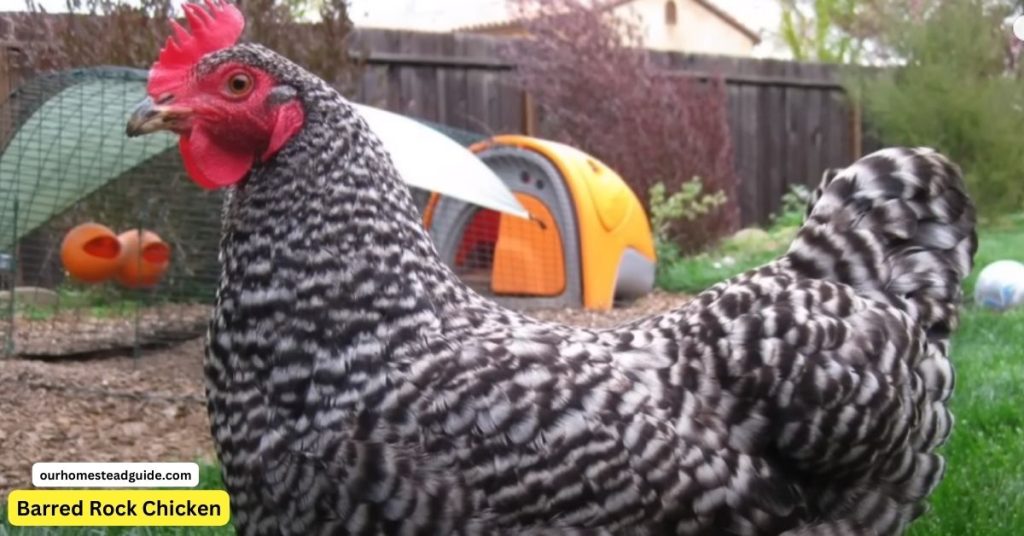
- Purpose: Egg production
- Temperament: Friendly
- Maximum Size: 7 lbs
Since the 1700s, Barred Rocks have been a traditional American breed.
Both hens and roosters have gregarious dispositions, and roosters can grow to be fairly large, weighing up to seven pounds.
They may lay up to 280 eggs a year, making them good layers as well.
This kind of chicken has distinctly barred white and black feathers, making it one of the most appealing to look at.
Maline
- Purpose: Dual-purpose (eggs and meat)
- Temperament: Docile
- Maximum Size: 12 lbs
A less popular breed of chicken, the Maline chicken got its start in Belgium in the 1800s.
One of the biggest chickens in the planet—its roosters can weigh up to a staggering 12 pounds—and it often competes with the Jersey Giant in its weight division!
Maline hens are exceptionally delicate and soft, even for their size. They’re excellent if you have little kids!
Feathers with a cuckoo pattern are seen in both males and females.
Not only are these serene birds valued for their attractive look, but they also produce a good 150 big brown eggs a year.
Although they aren’t as widely available as the full-sized version, bantam malines are still available.
Research and Planning:
Recognize the traits of the particular breed of chicken you wish to raise. Schedule the area and amenities required for your henhouse and run.
Acquire Necessary Supplies:
- Get or construct a suitable chicken coop that is predator-proof and has enough ventilation.
- Purchase heat lights, waterers, feeders, and nesting boxes as needed.
Selecting Chickens:
Whether buying from a local farm supply store, hatchery, or breeder, be sure the source of your chickens is reliable. Take into account characteristics such as the breed’s size, temperament, and ability to produce eggs.
Preparing the Coop:
Make sure there are no toxins present and the coop is clean.
Arrange bedding in the nesting boxes and cover the coop floor with the proper substrate.
Introducing Chickens to the Coop:
Introduce the hens to their new surroundings gradually.
Throughout the first few days, keep an eye on their behavior and health to make sure they adjust successfully.
Feeding:
Serve chickens with a comprehensive and well-balanced diet.
Depending on the breed, age, and goal (producing meat or eggs), alter the amount fed.
Watering:
- Make sure the hens have access to fresh, clean water at all times.
- To avoid infection, clean and sanitize waterers regularly.
Health Monitoring:
Check the hens frequently for symptoms of disease, wounds, or parasites.
Should any health concerns emerge, speak with a veterinarian.
Egg Collection and Handling:
Gather eggs every day to make sure they are fresh and clean.
Take caution when handling eggs to prevent cracks and contamination.
Social Interaction:
Spend time getting to know your hens so you can watch their behavior and establish trust.
Offer enrichment activities like as dust baths and perches.
Weather Considerations:
Adapt the insulation and ventilation of the coop to the weather.
When the weather is hot, give shade; when the weather is cold, make sure you have enough warmth.
Routine Maintenance:
Regularly clean the coop, discarding garbage and replacing any worn-out bedding.
Examine and fix any damage to the fencing or coop.
Record Keeping:
Maintain records of all vaccines, ovulations, and medical conditions.
Making decisions in the future will benefit from knowing this information.
Continuous Learning:
Keep yourself educated about the unique requirements and traits of your hen breed.
Join online or local poultry groups to get help and guidance.
Enjoy the Rewards:
Savor the fruits of your labor, whether they be meat, fresh eggs, or the happiness that comes from caring for these unusual hens.
Why Would You Want to Raise a Large Chicken Breed?
There are a number of reasons why you would want to consider growing a huge chicken.
Naturally, larger chickens make better broiler birds since they tend to generate more meat.
They are raised, nonetheless, since they tend to be more laid-back and might have temperaments that are more tranquil than those of other breeds.
You probably won’t have to worry too much about that kind of behavior with a huge chicken breed if you’ve ever dealt with flighty birds before.
These birds are better adapted to free-ranging since they typically stay there because they find it difficult to move their large weight off the ground.
When it comes to using these birds in your garden, some of them are really tall as well, which makes them great options.
Weeds and pests may be kept out of your growing regions more effectively by them since they can more readily access tall brush and vegetation.
Are Larger Chickens More Aggressive?
Rarely does a chicken’s size correspond to its behavior.
Larger chicken breeds actually have a tendency to be more submissive since they don’t feel as though they have to battle to be at the top of the food chain.
Although breed has no bearing on aggression, roosters are frequently more aggressive than hens.
This is more a gender issue than a size one; a rooster in its first year of life will typically be more aggressive, as will all roosters in the early spring.
Otherwise, your chicken’s unique disposition will have a greater direct impact on aggressiveness.
Regardless of the size or gender of your birds, giving them lots of space is the greatest approach to lessen violence in the flock.
Do Large Chickens Lay Larger Eggs?
Larger hens tend to lay larger eggs, but this isn’t always the case. If you want to raise chickens on a commercial scale and plan to raise them for egg production, choosing a breed of chicken based only on size might not be the best option.
Rather, you ought to choose a breed with a high egg production rate.
Even if there is some overlap—Rhode Island Reds, for instance, are huge chickens that also happen to produce an abundance of eggs—the two do not necessarily occur at the same time.
For example, White Leghorns are very little hens that lay a lot of eggs.
Consider huge breeds that also lay a good amount of giant- or jumbo-sized eggs if you’re searching for a large breed of chicken that also produces a lot of eggs. Some examples of large breeds that do this include:
- Marans
- Rhode Island Reds
- Langshans
- Jersey Giants
- Barred Rocks
- Welsummers
- Orpingtons
Do Large Chickens Have More Health Problems?
Larger chickens often don’t have any more health risks than smaller ones.
You don’t need to be concerned about your huge chickens dying from diseases particular to their size as long as you keep their living quarters clean and provide them the attention they need.
His is not without exception. Certain large-breed broiler chickens, such as Cornish Cross chickens, have undergone selective breeding to promote higher body mass and growth rates.
Because they may be killed sooner in life after reaching their maximum size, this makes them more efficient to produce.
However, these chickens develop so swiftly that they reach slaughter weight after only 42 days.
Since they would eat everything they come upon, they shouldn’t be given a free-range diet.
This heinous overindulgence in food may lead to health issues including obesity, gout, arthritis, and heart attacks.
Large breed chickens also have a higher risk of bumblefoot, illnesses, and damaged crops.
Because their bodies expand faster than their skeletal and joint systems can keep up, giant breed chickens can experience significant leg and joint issues.
Because of this, you must monitor your huge chicken to ensure its health, especially if it is a hybrid broiler breed.
Is a Large Chicken Breed Right for You?
There is no distinction between growing a huge chicken and any other size chicken.
But if you decide to grow larger birds, you do need to be aware that your infrastructure will be under more stress.
wider hens, for instance, require wider door openings, stronger roost bars, and additional room in the coop and run.
Larger nest boxes and additional food, of course, will also be necessary!
Raising a big breed of chicken might be a wise decision for your backyard flock if you can satisfy its requirements.
Most Frequently Asked Questions!
What is the Jersey Giant chicken?
One kind of chicken that is renowned for its size is the Jersey Giant. It was created in the US in the late 1800s, and its main purpose is to produce meat.
How big do the Jersey Giants get?
The Jersey Giants are renowned for their enormous stature. Hens usually weigh 10–12 pounds (4.5–5.4 kg), whereas roosters might weigh as much as 13–15 pounds (5.9–6.8 kg). The weights of different birds might differ.
What is the purpose of raising Jersey Giants?
Because Jersey Giants are dual-purpose birds, they may be raised for both meat and eggs. Even though they produce enormous brown eggs, their significant size typically leads to their being grown for meat.
Are Jersey Giants good layers?
Although Jersey Giants are not as prolific as some other breeds created especially for egg production, they are nevertheless respectable egg layers. However, many backyard chicken owners enjoy their huge brown eggs.
What are the different varieties of Jersey Giants?
The Jersey Giants are officially recognized in three colors: Black, White, and Blue. The Black Jersey Giant is the most prevalent color variant. prevalent
How do I care for Jersey Giants?
Jersey Giants require frequent health examinations, balanced food, and appropriate housing as part of their care. Because of their size, adequate room is required.
Can Jersey Giants be kept in a backyard setting?
It is possible to keep Jersey Giants in a backyard, but you need to keep in mind their size and area requirements. They are wonderful complements to a backyard flock and are typically submissive.
What is the lifespan of Jersey Giants?
Like other chicken breeds, Jersey Giants’ longevity is influenced by a variety of variables, including genetics, nutrition, and general care. They have a five to ten-year lifespan on average.
you may also like this article.

